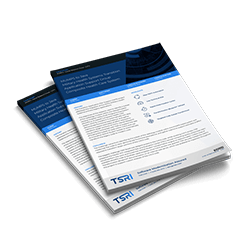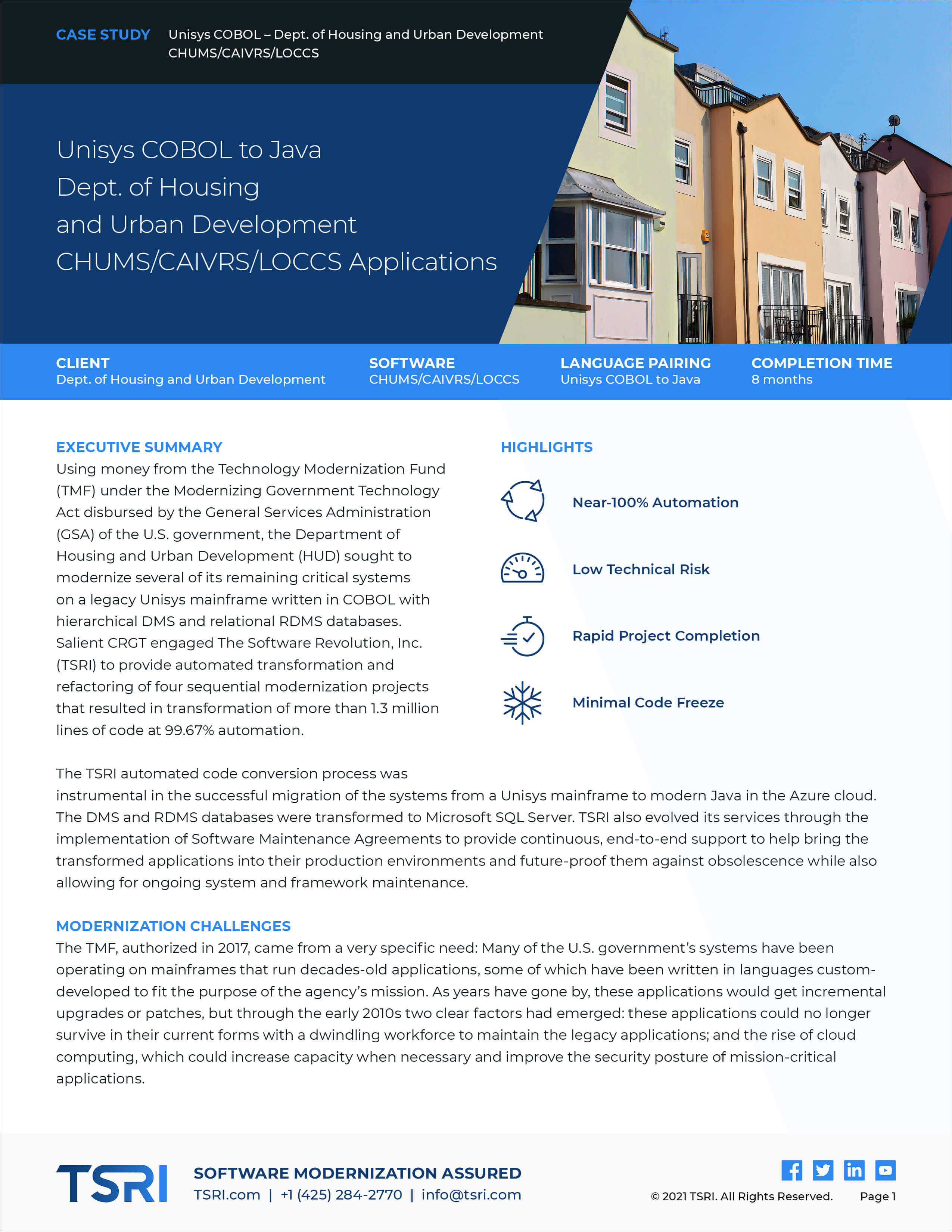Displaying items by tag: Automated Modernization
Lowered TCO by 90% - COBOL to Java on AWS for the U.S. Air Force
The U.S. Air Force's Integrated Logistics System - Supply (ILS-S), has been a cornerstone of military logistics for over five decades. This complex and mission-critical system, which tracks more than 35 million assets valued at $18 billion across 1.7 million warehouse locations, has been a significant part of the Air Force's operations, supporting 18,000 users and over 100,000 consumers of ILS-S information across 250 military installations.
Historically, the Air Force had attempted to modernize and move away from expensive Unisys Mainframes without success. Their earlier endeavors earned the system the nickname "The Beast" and was featured in a 2003 book on legacy system modernization by the Software Engineering Institute at Carnegie Mellon.
However, the outcomes changed dramatically when TSRI, NTT Data, and CGI leveraged TSRI’s model- and rule-based transformation and refactoring solution, JANUS® Studio, to modernize the 1.3 million lines of COBOL to Java and migrate the system to an elastic, secure, cloud-native environment on AWS GovCloud.
Watch Paul Saladna, Lead Architect at NTT Data discuss what made this project so successful!
In the initial phase, TSRI converted the 1.3 million lines of Unisys COBOL to modern, maintainable Java and the teams migrated the system to an on-prem mid-tier environment. In a second phase, the application underwent further automated refactoring by the teams for code quality and performance and then migrated to the AWS GovCloud, gaining the benefits of a cloud-native, scalable multi-tier environment like setting up DevSecOps and CI/CD pipelines and providing network interoperability.
This transformative project marked a significant milestone in automated modernization and cloud-native deployment for the Air Force and has been heralded as a huge success by the USAF, setting a precedent for future modernizations.
“All told, we started at $30 million prior to the modernization and ended at about $3 million post-modernization; a pretty significant cost savings!”
Paul, who started with ILS-S back in 2003, played a pivotal role in transitioning the system from a fragmented, green-screen-based setup to a unified cloud-computing solution. His leadership was instrumental in steering the project from its inception, through its on-prem modernization phase, to its ultimate migration to a cloud-native architecture on AWS.
The modernization's driving forces were multifaceted, focusing on reducing infrastructure costs, mitigating COBOL developer dependency, and enhancing platform stability and capabilities. The Air Force required a fast and seamless transition with no loss in functionality or performance, despite the concurrent challenges posed by active military engagements.
The decision to adopt AWS GovCloud was influenced by the Air Force's existing computational frameworks and the natural fit of AWS for Java/Python-based projects, given its extensive use and the associated economies of scale.
TSRI was chosen for this monumental task through a rigorous selection process, showcasing unparalleled automation capabilities and a thorough understanding of the legacy COBOL code, which set them apart from other vendors.
“TSRI demonstrated the highest degree of conversion capabilities and past performance and represented the lowest risk for us to achieve mission objectives. Really, they stood out.”
The outcomes of this modernization are profound, achieving a 90% reduction in total costs—from $30 million annually to approximately $3 million post-modernization. Additionally, the project facilitated the reassignment of COBOL developers to roles where their deep understanding of the system's logic and business requirements could be leveraged for the modernized ILS-S system.
The modernized ILS-S now boasts a remarkable 99.999% uptime, a testament to the enhanced platform stability and capabilities achieved through this project. This success has prompted the Business and Enterprise Systems Directorate (BES) of the USAF to replicate this modernization model across other critical systems, with TSRI currently working on the modernization of the Air Force's wholesale Stock Control System.
This journey from COBOL to Java, culminating in a truly cloud-native deployment on AWS, not only signifies a technological leap for the Air Force but also exemplifies a model of collaboration, innovation, and strategic foresight in modernizing critical defense systems.
To learn more about the project, read the case study
TSRI is Here for You
As a leading provider of software modernization services, TSRI enables technology readiness for the cloud and other modern architecture environments. We bring software applications into the future quickly, accurately, and efficiently with low risk and minimal business disruption, accomplishing in months what would otherwise take years.
See Case Studies
Learn About Our Technology
Get Started on Your Modernization Journey Today!
Additional Sources:
- https://federalnewsnetwork.com/it-modernization/2022/11/lessons-learned-from-air-forces-ils-s-logistics-system-modernization/
- https://www.aflcmc.af.mil/News/Article-Display/Article/2888877/system-tracks-every-item-in-the-air-force-inventory/
Pitney Bowes - Tier 3/Comet Server VB6 to C# .NET Core Modernization on AWS
TSRI adapted its industry-leading modernization capabilities to the unique Pitney Bowes Visual Basic 6 (VB6) code constructs for a successful automatic modernization of over 443,000 lines of VB6 code and over 450,000 lines of XML meta-data to modern C# .NET Core coming in well within budget and completing the transformation earlier than scheduled.
Additionally, TSRI’s partner, Accenture, had the opportunity to manually rewrite the user interfaces for the application, to achieve a modern and user-friendly experience, while TSRI simultaneously completed the automated transformation of the application code and database written in VB6. As a result, the application achieved total functional equivalence while the look and feel of the front end was greatly improved.
 |
|
- VB6
- C#
- Automatic Refactoring
- VB6 Modernization
- architecture
- Software Modernization
- modernization
- transformation blueprint
- Microsoft SQL Server
- JANUS Studio®
- Code Warranty
- SonarQube
- Functional Equivalence
- Containerized on AWS
- C# NET Core
- Refactoring
- Data Migration
- Database Modernization
- Code Documentation
- automated refactoring
- Automated Modernization
- Cloud Native
Video: Modernizing HUD from Unisys Mainframe to Cloud with Roger Knapp
Only a few engineers know how it feels to lead a major government agency through an automated mainframe modernization for multiple applications from COBOL to Java on the Microsoft Azure cloud. TSRI’s Executive Vice President of Engineering & Service Delivery, Roger Knapp, is one of them!
Get the story straight from Roger in his interview with GovCIO about his experiences modernizing multiple applications for the U.S. Department of Housing and Urban Development (HUD).
Also, be sure to check out TSRI’s case study to learn more about our work with GovCIO to transform multiple Mainframe Unisys 2200 COBOL with DMS2200 databases to Java with a factory-style process. The modernized systems were deployed on the Microsoft Azure Cloud and hook directly into the Microsoft Azure DevOps pipeline!
TSRI utilized the same proven JANUS Studio® modernization solution, process, and approach we have leveraged for our other IBM, Tandem, Unisys, and other mainframe modernizations. During the project, TSRI provided “As-Is” and “To-Be” application documentation. We utilized our powerful refactoring engine to improve code quality, maintainability, readability, and security to meet the HUD’s needs. HUD’s modernized applications (CHUMS, F42d/CAIVRS, and LOCCS) are live, in production, and being actively maintained by Java developers.
This program was also the first-ever modernization utilizing the U.S. Technology Modernization Fund (TMF) distributed by the General Services Administration (GSA) and hailed as a resounding success! Maria Roat, the deputy federal chief information officer, shared in a CompTIA webinar that the U.S. government’s technology modernization fund (TMF) is about accelerating projects and enabling multi-year funding.
“HUD mainframe modernization, there’s a playbook coming out of that. So other agencies, they’re going through their mainframe modernization, they can take lessons learned from HUD and apply that,” she said. “As we as we look to scale and accelerate the board, there’s a lot of things that we’ve already done over the last three years, as we’ve matured, that we can apply to the future funding.”
TMF allowed HUD to move off the mainframe completely, get OPEX savings and achieve an amazing reduction in TCO for the Department (80%+ compared to the mainframe TCO).
Download the full case study and learn more.
TSRI is Here for You
As a leading provider of software modernization services, TSRI enables technology readiness for the cloud and other modern architecture environments. We bring software applications into the future quickly, accurately, and efficiently with low risk and minimal business disruption, accomplishing in months what would otherwise take years.
See Case Studies
Learn About Our Technology
Get Started on Your Modernization Journey Today!
AWS Blog Featured Post: Automated Refactoring of a U.S. Department of Defense Mainframe to AWS
United States Air Force SBSS ILS-S COBOL to Java on AWS Modernization
A major component of the system is 54 years old, written in COBOL, and provides retail-level business logic. The component runs on mainframes that have proven to be extremely difficult to change and manage, and the DoD needed to modernize the component to drive down operating costs and move to an open platform, while retaining all functionality....
Government Modernization Breaks Loose
During the past two months Federal government modernization has gained steam--first with the Administration’s modernization plan, released for comment at the end of August, followed by final movement on the critical Modernizing Government Technology (MGT) Act which gained Senate approval on September 18.
Code Modernization & Language: The Eurocat Ada Transformation
Code modernization can create some interesting problems these days as business and government attempt to upgrade legacy systems. The route ahead is not always clear. Legacy systems may be in a variety of different languages installed for different purposes to meet the needs of the time. Even the transformation target itself can be problematic. Whether code is better translated into Java, a C variant, Python or something else demands consideration of the environment in which the code will reside, its interconnections, as well as the characteristics of the output language and its suitability. Economics rises as an important issue with older or obscure languages that do not have a breadth of available talent.

